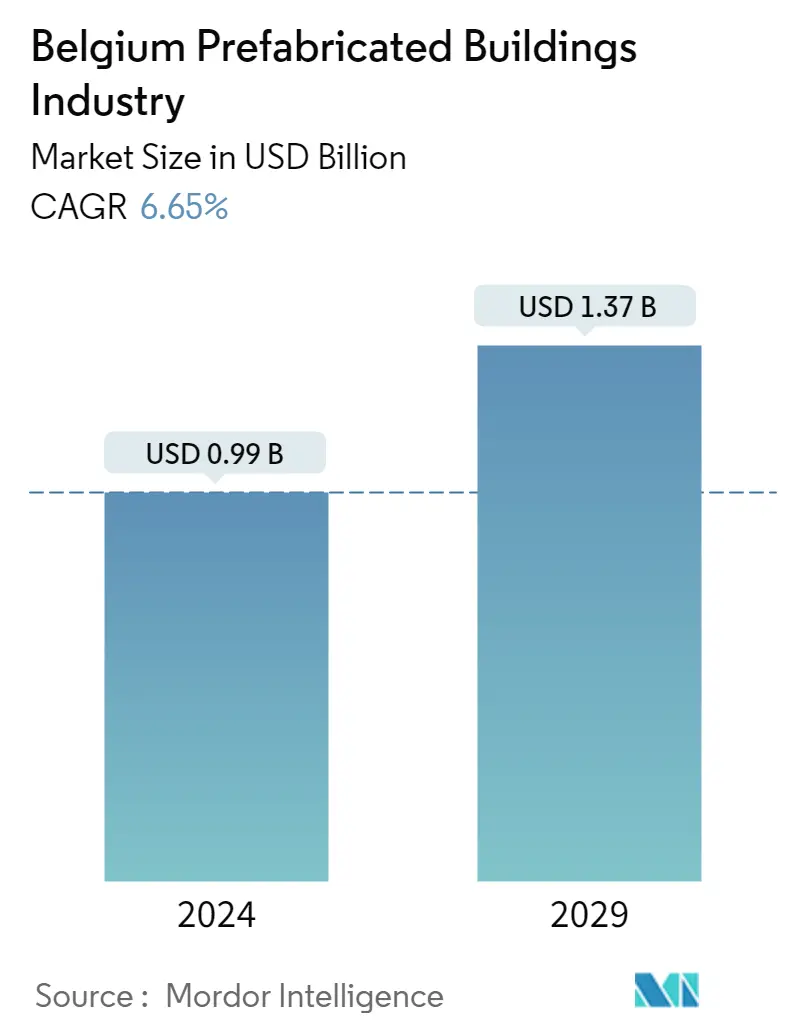Market Size of Belgium Prefabricated Buildings Industry

| Study Period | 2020 - 2029 |
| Base Year For Estimation | 2023 |
| Market Size (2024) | USD 0.99 Billion |
| Market Size (2029) | USD 1.37 Billion |
| CAGR (2024 - 2029) | 6.65 % |
| Market Concentration | Medium |
Major Players
*Disclaimer: Major Players sorted in no particular order |
Belgium Prefabricated Buildings Market Analysis
The Belgium Prefabricated Buildings Industry is expected to grow from USD 0.99 billion in 2024 to USD 1.37 billion by 2029, at a CAGR of 6.65% during the forecast period (2024-2029).
Space constraints in big cities, high profitability, increased demand for high-end and customized buildings are the driving factors of the prefabricated buildings industry.
The COVID-19 pandemic has brought serious uncertainty to many suppliers and contractors in the Belgium construction industry. Due to the blockade, some construction companies were forced to close their projects, while others witnessed delays in their projects. Due to COVID-19, only a few general construction sites were open, and the productivity of these sites was near 20% of the total planned daily output level. However, unlike remote construction, traditional buildings require a lot of labor, so choosing prefabricated buildings has become the best solution to avoid the spread of diseases.
Steel is the most widely used material in prefabricated construction in Belgium owing to its proven strength and durability. Although the residential sector in the area dominates, the demand for prefabricated parts in the non-residential sector is slightly higher. This is because commercial spaces such as shopping malls and hospitals need to be built quickly. Due to its lightweight, ductility, and recyclability, steel structures are used in prefabricated buildings at a high rate. These reconstructions are highly recognized in the architectural field because they can absorb wind turbulence and provide high resilience during earthquakes.
Belgium Prefabricated Buildings Industry Segmentation
Prefabricated buildings (also known as prefabs) are the building structures manufactured offsite and transported to the on-site assembly location. This report covers market insights, such as market dynamics, drivers, restraints, opportunities, technological innovation, and its impact, porter's five forces analysis, and the impact of COVID-19 on the market. In addition, the report also provides company profiles to understand the competitive landscape of the market.
Belgium's Prefabricated Buildings Industry is segmented by Application (Residential, Commercial, and Industrial).
| By Application | |
| Residential | |
| Commercial | |
| Industrial |
Belgium Prefabricated Buildings Industry Size Summary
The Belgium prefabricated buildings market is poised for significant growth, driven by factors such as space constraints in urban areas, high profitability, and a rising demand for high-end, customized structures. The industry has shown resilience in the face of challenges posed by the COVID-19 pandemic, which disrupted traditional construction methods due to labor-intensive requirements. Prefabricated buildings emerged as a viable solution to maintain productivity while minimizing health risks. Steel remains the predominant material used in these constructions, valued for its strength, durability, and recyclability, particularly in the non-residential sector where rapid construction is essential. Despite the competitive landscape and high labor costs, the market is expected to expand, supported by increasing urbanization and the need for new residential and commercial spaces.
The demand for prefabricated houses in Belgium is on the rise, fueled by urbanization and population growth, with a significant portion of the population residing in urban areas. The market is characterized by a fragmented structure with both domestic and international players, leading to intensified competition through product innovations and strategic mergers and acquisitions. Companies are increasingly focusing on eco-friendly materials and energy-efficient designs to differentiate their offerings. Major industry players are actively involved in significant projects, such as the construction of new sports arenas and modern retail spaces, which are expected to drive further market growth. The ongoing investments in prefabricated construction and the adoption of sustainable practices are key factors contributing to the industry's positive outlook.
Belgium Prefabricated Buildings Industry Market Size - Table of Contents
-
1. MARKET INSIGHTS
-
1.1 Current Market Scenario
-
1.2 Technological Trends
-
1.3 Insights on Supply Chain/Value Chain Analysis of the Prefabricated Buildings Industry
-
1.4 Brief on Different Structures Used in the Prefabricated Buildings Industry
-
1.5 Cost Structure Analysis of the Prefabricated Buildings Industry
-
1.6 Impact of COVID-19 on the Market
-
1.7 Insights on Different Types of Materials used in Prefabricated Buildings Construction
-
-
2. MARKET SEGMENTATION
-
2.1 By Application
-
2.1.1 Residential
-
2.1.2 Commercial
-
2.1.3 Industrial
-
-
Belgium Prefabricated Buildings Industry Market Size FAQs
How big is the Belgium Prefabricated Buildings Market?
The Belgium Prefabricated Buildings Market size is expected to reach USD 0.99 billion in 2024 and grow at a CAGR of 6.65% to reach USD 1.37 billion by 2029.
What is the current Belgium Prefabricated Buildings Market size?
In 2024, the Belgium Prefabricated Buildings Market size is expected to reach USD 0.99 billion.

